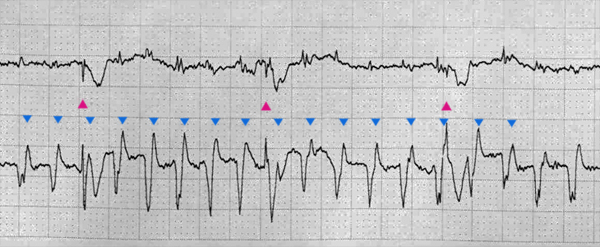paced rhythm
First Glance:
From across the room it looks like a raging rapid narrow-complex tachycardia, or possibly some kind of repetitive motion artifact.
Discussion:
The striking lower trace is a ‘V’ lead with 160% voltage calibration (obscured by folded corner in this scan). The most obvious finding is regular waves at a hair under 300 bpm. In addition, we can see some regular hiccups in the baseline, best seen in the upper trace: lead II.
With the baseline a little more sedated in lead II this allows us to better appreciate the regular wide complexes @ 50 bpm. Just before each of these in the upper trace is a sharp ultra-narrow S which is most consistent with a ventricular pacing spike (marked with the magenta triangles). The fact that they are exactly 1200 ms apart across the entire strip is consistent with exogenous pacing.

Where are those high-speed waves coming from? Atrial flutter comes to mind. If we doubted the pacing theory we might wonder if this is atrial flutter with a high-grade block (this would be about 6:1, which does happen) but the atrial waves (marked here with the blue triangles) are not synchronized to the ventricular waves.
When we look closely at the upper trace’s rapid narrow spikes they sometimes look suspicious for pacing spikes. However, far and away the most likely possibility is that this is artifact. Some motion artifacts from vibrating chest-PT beds, machinery, electrical equipment, etc, can give similar appearances.
Final Impression?
Ventricular pacing with 100% capture at 50 bpm, with marked regular artifact.
Management implications:
If the patient has symptomatic bradycardia with a pacer, it’s a little more interesting. Is it a pacer malfunction, or underpacing? Atropine isn’t going to do squat in the setting of 3rd degree block. I’d guess that sympathomimetics and inotropes would do little either. If this is a patient in distress, then this man might need a magnet and some external pacing while you’re waiting for the cardiologist and the interrogator.
The Take-home Point:
This tele alarm was auto-interpreted as a tachycardia of 214 bpm, which it clearly isn’t.
Be wary of all automated rhythm interpretations. I find the interpretations generated by the 12L machines and the telemetry boxes alike are best treated like differentials from a medical student (this author included). You should consider them seriously because they may pick up on something you didn’t, but be highly skeptical. For best sensitivity, look at the auto-interpretation after you have already come to your own conclusions (or given up) as you may miss the correct diagnosis due to ‘satisfaction of search’ error.
![]() Two star strip. The meat and potatoes.
Two star strip. The meat and potatoes.
